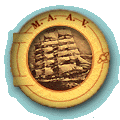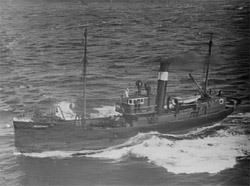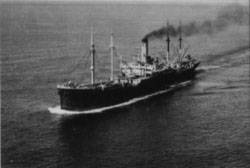|
|

|
||||||
|

|
![]() he HMAS Goorangai was the first Royal Australian Navy vessel lost in World War II, and the first RAN surface vessel to be lost in wartime.
The entire ship's complement consisting of three officers and twenty one sailors (twenty four in total) were killed in the tragedy, with only six bodies recovered, of which five were identified.
he HMAS Goorangai was the first Royal Australian Navy vessel lost in World War II, and the first RAN surface vessel to be lost in wartime.
The entire ship's complement consisting of three officers and twenty one sailors (twenty four in total) were killed in the tragedy, with only six bodies recovered, of which five were identified.
The Goorangai was built for the NSW Government at the State Dockyard, Newcastle in 1919. It was sold to Cam & Sons in 1926 and refitted as a fishing trawler. At the outbreak of war, the Goorangai was one of thirty five privately owned vessels requisitioned by the RAN as auxiliary minesweepers. These vessels helped to fill the wide gap in the minesweeper department of the RAN. The largest number of minesweepers requisitioned from any one body was eight during 1939 - 1943, from Cam & Sons Pty Ltd of Pyrmont, NSW. The Goorangai was one of these vessels. Two of Cam & Sons' vessels were lost during the war, HMAS Goorangai having been lost in collision 20 November 1940, and HMAS Patricia Cam, sunk by enemy aircraft 22 January 1943. On the 29 June 1943, the remaining six vessels were purchased by the Commonwealth. These vessels were crewed mainly from the reserve force. In the Goorangai's case, the RAN persuaded sixteen of its fisherman crew to sign up. A number were Scots who had come to Australia on delivery voyages aboard trawlers built in Scottish yards. By the time of the sinking all but two of the crew were Australians. The Scottish skipper of the Goorangai, David McGregor, was one of those signed up by the RAN. He was kept on as skipper and given rank of Commissioned Warrant Officer. He was lost with the ship.

|
Following German mine laying operations off Wilson's Promontory and Cape Otway on the nights of 29, 30 and 31 October 1940, and subsequent losses on the 7th and 8th of November of two ships, the steamer Cambridge at Wilson's Promontory and the freighter City Of Rayville at Cape Otway, the RAN ordered the minesweepers Goorangai, Orana and Durraween into Bass Strait to locate and destroy the minefields.
At about 8.3Opm on 20 November HMAS Goorangai (223 tons), whilst steaming from Queenscliff to Portsea, was struck forward of the funnel by HMAT Duntroon (10,346 tons gross) which was leaving for Sydney loaded with troops. The Goorangai was cut in two and sank in less than a minute in the approaches to the South Channel. Wartime security prevented the Duntroon from heaving to or switching on searchlights to look for survivors. However, the Duntroon did lower lifeboats, fire rockets, and sound three blasts on the whistle to alert the residents of Queenscliff. When the lifeboat Queenscliffe reached the scene of the disaster the crew found the minesweeper sunk in about 15 metres of water with only the tops of the masts visible. Despite an extensive search only six bodies were recovered.
Blasting operations in January 1941 reduced the remains of the Goorangai to large and small sections of steel plating which protrude from the sandy seabed. A small cylindrical boiler (2m x 3m) is lying on the northern end of the site. Broken machinery and boiler sections are scattered around the site, and occasionally wartime relics such as gas masks can be seen.
The remains cover approximately 200 square metres of the seabed, and a considerable length of hull plating stands proud of the sand to a height of about two metres. The remains of the hull have been colonised by a diverse assemblage of colourful encrusting organisms, such as bryozoans, sponges and soft corals. This in turn provides an ideal habitat for both free swimming and sedentary fauna, including many fish species, cuttlefish, sea horses, nudibranches and starfish. The abundance and variety of marine life, in association with the shipwreck, makes the HMAS Goorangai a popular destination for sport divers.
MEMBERS OF CREW LOST ON HMAS GOORANGAI
G. Boyle
A. Carter
H. Gilroy
F. Hack
A. Ladlow
D. McGregor
K. Matheson
R. Redman
B. Buchanan
C. Cox
C. Green
H. Johnson
A. MacDonell
E. McLaughlan
J. Moxey
J. Saunders
J. Dungey
W. Johnston
M. Madden
F. Wadds
N. Farquharson
A. Kemp
L. Mainsbridge
R. Wadrop
Wartime wrecks lost on the Victorian coast,
Cambridge (Steamer, 10,846 tons, British owned, mined and sunk off Wilson's Promontory 7-11-40, one life lost). Note: Historic Shipwreck.
City of Rayville (MV, 5,883 tons, United States Maritime Commission owned, mined and sunk off Cape Otway 8-11-40, one life lost).
HMAS Goorangai (Steamer, 223 tons, built 1919 Newcastle, NSW, RAN owned, collision and sunk off Queenscliff 20-11-40, twenty four lives lost).
Iron Crown (3,353 tons, built 1922 Williamstown Vic, BHP owned, torpedoed and sunk by Japanese submarine 1.24 off Gabo Island, 4-6-42, thirty seven lives lost.
Extract
![]()
![]()
The above text is an extract from, Goorangai, case for declaration as an Historic Shipwreck', written and presented by MAAV member Terry Arnott. The Goorangai was subsequently declared as a Historic Shipwreck on the 16th of November 1995.